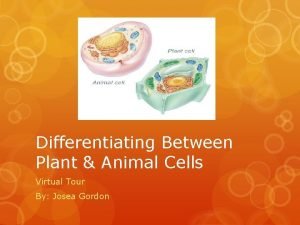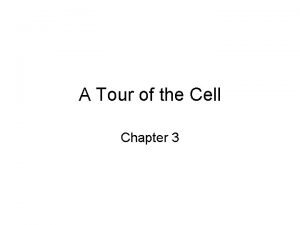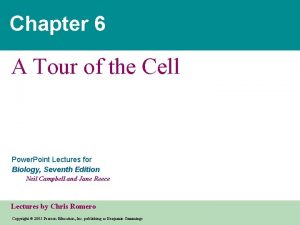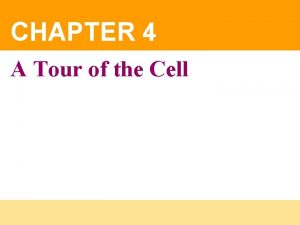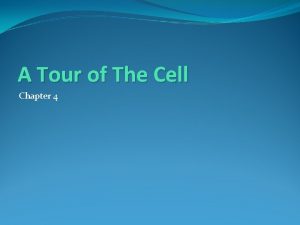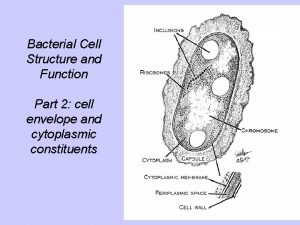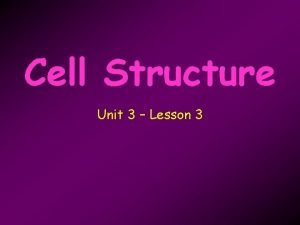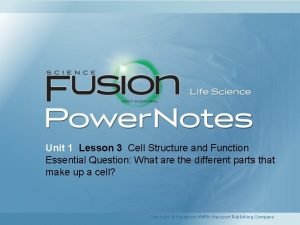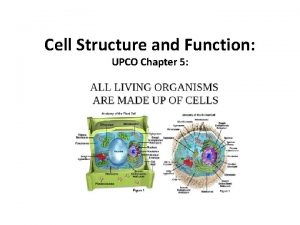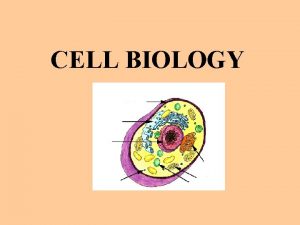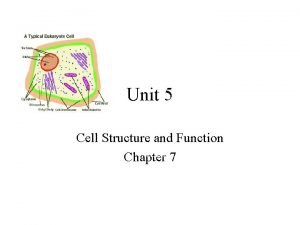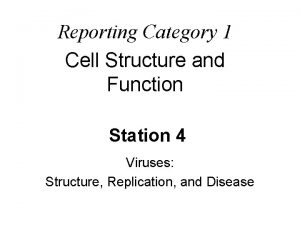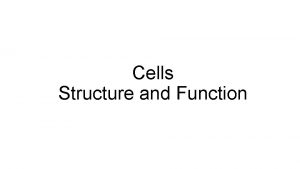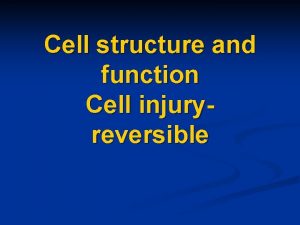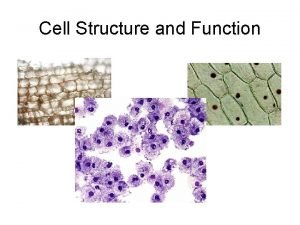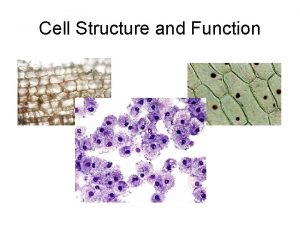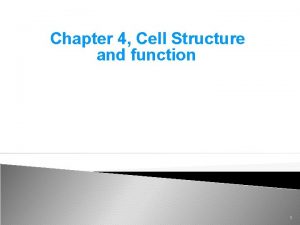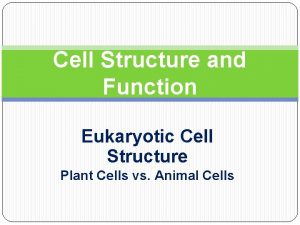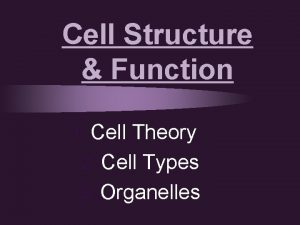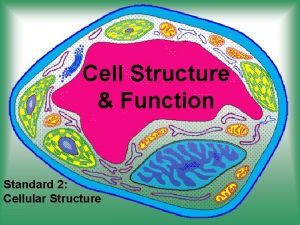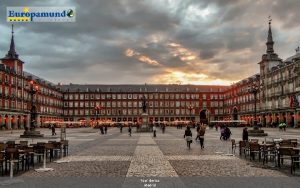A Tour of the Cell Structure and Function














































- Slides: 46

A Tour of the Cell Structure and Function Power. Point® Lecture Slides for Essential Biology, Second Edition & Essential Biology with Physiology Neil Campbell, Jane Reece, and Eric Simon Presentation prepared by Chris C. Romero Copyright © 2004 Pearson Education, Inc. publishing as Benjamin Cummings

THE MICROSCOPIC WORLD OF CELLS • Cells are the basic units of life • Cell function limits cell size – Cell size is from 5 to 50 um Copyright © 2004 Pearson Education, Inc. publishing as Benjamin Cummings

Cell Theory • All living things are composed of cells • Cells are the basic unit of life • Cells come from pre-existing cells Copyright © 2004 Pearson Education, Inc. publishing as Benjamin Cummings

The Two Major Categories of Cells • The countless cells on earth fall into two categories – Prokaryotic cells – Eukaryotic cells Copyright © 2004 Pearson Education, Inc. publishing as Benjamin Cummings

• Prokaryotic and eukaryotic cells differ in several respects Prokaryotic cell Nucleoid region Eukaryotic cell Copyright © 2004 Pearson Education, Inc. publishing as Benjamin Cummings Nucleus Organelles Figure 4. 4

Cell Types • Prokaryotic: (Bacteria) – Smaller, simple structure, single celled – No membrane bound organelles – No nucleus: instead, it has a nucleoid region – One chromosome, found in the nucleoid region • Eukaryotic: (Prostista, Plants, Fungi, Animals) – Larger, more complex, simple and multicellular – Has membranous organelles – Has a nucleus – Multiple chromosomes Copyright © 2004 Pearson Education, Inc. publishing as Benjamin Cummings

Generalized Prokaryote Nucleoid DNA Flagellum Plasma Membrane Copyright © 2004 Pearson Education, Inc. publishing as Benjamin Cummings

Generalized Animal and Plant Cell Animal Cell Centrioles Chloroplasts Mitochondria Golgi Nucleus Endoplasmic Reticulum Copyright © 2004 Pearson Education, Inc. publishing as Benjamin Cummings Plant Cell

Generalized Plant and Animal Cell Nucleolus Ribosomes Central Vacuole Smooth E. R. Cell Wall Copyright © 2004 Pearson Education, Inc. publishing as Benjamin Cummings Plant Cell

A Panoramic View of Eukaryotic Cells • An idealized animal cell Ribosomes Cytoskeleton Centriole Lysosome Flagellum Not in most plant cells Plasma membrane Nucleus Mitochondrion Rough endoplasmic reticulum (ER) Golgi apparatus Smooth endoplasmic reticulum (ER) Figure 4. 6 A Copyright © 2004 Pearson Education, Inc. publishing as Benjamin Cummings

• An idealized plant cell Not in animal cells Cytoskeleton Mitochondrion Central vacuole Nucleus Cell wall Rough endoplamsic reticulum (ER) Chloroplast Ribosomes Plasma membrane Smooth endoplasmic reticulum (ER) Plasmodesmata Golgi apparatus Copyright © 2004 Pearson Education, Inc. publishing as Benjamin Cummings Figure 4. 6 B

Nucleus and Ribosomes: Genetic Control of the Cell Structure and function of Nucleus and Ribosomes • The nucleus is bordered by a double membrane called the nuclear envelope (separates nuclear material from the cytoplasm, contains pores/exchange of material) – It contains chromatin (genes/DNA in threadlike chromosomes) – It contains a nucleolus (site of ribosome assembly) • Ribosomes make all the cell’s proteins Copyright © 2004 Pearson Education, Inc. publishing as Benjamin Cummings

Ribosomes Chromatin Nuclear envelope Nucleolus Pore Figure 4. 9 Copyright © 2004 Pearson Education, Inc. publishing as Benjamin Cummings

The Nucleus Nucleolus Pores Chromatin Threads (Chromosomes) Copyright © 2004 Pearson Education, Inc. publishing as Benjamin Cummings Nuclear Envelope

How DNA Controls the Cell • DNA controls the cell by transferring its instructions to RNA – The information in the RNA is used to make proteins Figure 4. 10 Copyright © 2004 Pearson Education, Inc. publishing as Benjamin Cummings DNA 1 DNA gives Instructions to RNA Nucleus Cytoplasm 2 Movement of RNA into cytoplasm via nuclear pore 3 RNA carries instructions to make proteins to the ribosomes RNA Ribosome Protein

THE ENDOMEMBRANE SYSTEM: MANUFACTURING AND DISTRIBUTING CELLULAR PRODUCTS • Many of the membranous organelles in the cell belong to the endomembrane system which include the following: – Endoplasmic reticulum – Golgi apparatus – Lysosomes – Vacuoles Copyright © 2004 Pearson Education, Inc. publishing as Benjamin Cummings

The Endoplasmic Reticulum • The endoplasmic reticulum (ER) Nuclear envelope – Series of interconnecting membranes, enclosed tubes and channels in the cytoplasm – Produces an enormous variety of molecules – Is composed of smooth and rough ER Ribosomes Rough ER Smooth ER Figure 4. 11 Copyright © 2004 Pearson Education, Inc. publishing as Benjamin Cummings

Endoplasmic Reticulum Unit Membrane Ribosomes Vesicles forming Copyright © 2004 Pearson Education, Inc. publishing as Benjamin Cummings

Rough ER • The “roughness” of the rough ER is due to ribosomes that stud the outside of the ER membrane – Ribosomes are the site of protein synthesis - types of proteins produced are as follows: • Membrane proteins – produce new membrane • Secretory proteins – proteins that are secreted by the cell and transported elsewhere • Example: salivary glands contain a lot of rough ER, the ribosomes there make lots of enzymes to help disolve food in the mouth. Copyright © 2004 Pearson Education, Inc. publishing as Benjamin Cummings

• After the rough ER synthesizes a molecule it packages the molecule into transport vesicles 4 Transport vesicle buds off Ribosome 3 1 Protein 2 Secretory protein inside transport vesicle Rough ER Polypeptide Figure 4. 12 Copyright © 2004 Pearson Education, Inc. publishing as Benjamin Cummings

Smooth ER • The smooth ER lacks the surface ribosomes of ER and produces lipids, including steroids • Examples: – Ovaries and Testes – smooth ER produces sex hormones, which are steroids. These organs are enriched with smooth ER – In the liver, smooth ER produces enzymes that detoxify harmful drugs and metabolic by products Copyright © 2004 Pearson Education, Inc. publishing as Benjamin Cummings

The Golgi Apparatus • The Golgi apparatus – Works in partnership with the ER, its membranes are derived from the ER – Sorts, modifies, packages and distributes the products of cells Transport vesicle from ER “Receiving” side of Golgi apparatus New vesicle forming Transport vesicle from the Golgi “Shipping” side of Golgi apparatus Plasma membrane Figure 4. 13 Copyright © 2004 Pearson Education, Inc. publishing as Benjamin Cummings

Golgi Apparatus Summary: How it works • Vesicles from the ER fuse to one side of golgi, they empty their contents into the golgi sacs. The contents are then modified and repackaged. • On the opposite side of the stack of membranes, vesicles carry away proteins, lipids and other complex molecules to other parts of the cell or body. Copyright © 2004 Pearson Education, Inc. publishing as Benjamin Cummings

The Golgi Complex Material Received From ER Material Destined for Export TEM Copyright © 2004 Pearson Education, Inc. publishing as Benjamin Cummings

Lysosomes • A lysosome is a membrane-enclosed sac – It contains digestive enzymes and serves as cells digestive system – The enzymes break down lipids, carbohydrates and proteins and also old organelles – In the golgi, these digestive enzymes are packaged into lysosomes Copyright © 2004 Pearson Education, Inc. publishing as Benjamin Cummings

Lysosomes break down damaged organelles Lysosome Digestion Damaged organelle (b) Lysosome breaking down damaged organelle Figure 4. 14 b Copyright © 2004 Pearson Education, Inc. publishing as Benjamin Cummings

The Flow of Membrane Lysosome Endoplasmic Reticulum Destined for Export Golgi Destined for Golgi Copyright © 2004 Pearson Education, Inc. publishing as Benjamin Cummings

• A review of the endomembrane system Rough ER Transport vesicle from ER Golgi apparatus Secretory vesicle from Golgi Secretory protein Vacuole Plasma membrane Figure 4. 16 Copyright © 2004 Pearson Education, Inc. publishing as Benjamin Cummings Lysosome

Vacuoles • Vacuoles are membranous sacs: function in water regulation, support and storage – Types are the contractile vacuoles of protists, the central vacuoles of plants and food vacuoles Central vacuole Contractile vacuoles (a) Contractile vacuoles in a protist (b) Central vacuole in a plant cell Figure 4. 15 Copyright © 2004 Pearson Education, Inc. publishing as Benjamin Cummings

Contractile Vacuole • Expels water out of single-celled freshwater animals Copyright © 2004 Pearson Education, Inc. publishing as Benjamin Cummings

Contractile Vacuoles Paramecium sp. Expanded with Water 1 2 Copyright © 2004 Pearson Education, Inc. publishing as Benjamin Cummings Expelling Water Wate to Outside

Central Vacuoles • Large, water-filled spaces • Can take up over 90% of cell volume • Functions: – Gives support and shape to plant cells Copyright © 2004 Pearson Education, Inc. publishing as Benjamin Cummings

Plant Wilting & the Central Vacuole Cytoplasm Normal Plant Cell In Drought Normal In Drought Vacuo le Space between Cell Wall and Cell Membrane Copyright © 2004 Pearson Education, Inc. publishing as Benjamin Cummings

CHLOROPLASTS AND MITOCHONDRIA: ENERGY CONVERSION • Cells require a constant energy supply to do all the work of life • Two types of organelles involved in supplying energy to cells are: – Chloroplast – Mitochondria Copyright © 2004 Pearson Education, Inc. publishing as Benjamin Cummings

Chloroplast • Site of photosynthesis, only in plant cells • Convert light energy into chemical energy of food • Captures light energy and turns it into sugar • Contains the green pigment Copyright © 2004 Pearson Education, Inc. publishing as Benjamin Cummings

The Chloroplast Copyright © 2004 Pearson Education, Inc. publishing as Benjamin Cummings

Mitochondria • Called the “Powerhouse” of the cell • Cellular respiration, uses the chemical energy of sugar molecules and converts it into another form of chemical energy called ATP Copyright © 2004 Pearson Education, Inc. publishing as Benjamin Cummings

Mitochondria Outer Membrane Cristae Copyright © 2004 Pearson Education, Inc. publishing as Benjamin Cummings Matrix

THE CYTOSKELETON: CELL SHAPE AND MOVEMENT • The cytoskeleton is a network of fibers that extend throughout the cytoplasm of the cell • Functions: – Support: The cytoskeleton gives mechanical support to the cell and maintains cell shape – Movement: Organelles move within the cell by the means of microtubules that are attached to the organelles Copyright © 2004 Pearson Education, Inc. publishing as Benjamin Cummings

The Cytoskeleton Plasma Membrane Mitochondrion Microtubule Endoplasmic Reticulum Copyright © 2004 Pearson Education, Inc. publishing as Benjamin Cummings

Cilia and Flagella • Cilia and flagella are motile appendages or extensions of the cell that aid in locomotion • Cilia and flagella are composed of microtubules • Functions: – Flagella: Singular whip like structures that propel the cell by undulating whip like motion – Cilia: Shorter and more numerous than flagella, promote movement by a coordinated back-forth movement Copyright © 2004 Pearson Education, Inc. publishing as Benjamin Cummings

• Human sperm have flagella, used to propel the sperm • Protist such as the paramecium have cilia that move in a back-andforth motion Figure 4. 20 A, B Copyright © 2004 Pearson Education, Inc. publishing as Benjamin Cummings

Movement of Flagella Water Corkscrew Movement Whipping Movement (Pulls) (Pushes) Scanning E. M. of sperm on egg Copyright © 2004 Pearson Education, Inc. publishing as Benjamin Cummings

Cilia are also found in non-motile cells such as those of the lungs Your windpipe also has a ciliated lining Figure 4. 20 C Copyright © 2004 Pearson Education, Inc. publishing as Benjamin Cummings

Movement of Cilia Power Stroke Recovery Stroke Water Scanning E. M. of a ciliate Copyright © 2004 Pearson Education, Inc. publishing as Benjamin Cummings

The End of Chapter 7 Power. Point® Lecture Slides for Essential Biology, Second Edition & Essential Biology with Physiology Neil Campbell, Jane Reece, and Eric Simon Presentation prepared by Chris C. Romero Copyright © 2004 Pearson Education, Inc. publishing as Benjamin Cummings
 Differentiate between a guide and an escort.
Differentiate between a guide and an escort. Shanghai world financial tour eiffel tour petronas
Shanghai world financial tour eiffel tour petronas Dangerous world tour setlist
Dangerous world tour setlist Virtual cell tour
Virtual cell tour A tour inside the cell answers
A tour inside the cell answers Intercellular connections
Intercellular connections A tour of the cell chapter 4
A tour of the cell chapter 4 A tour of the cell chapter 4
A tour of the cell chapter 4 What is the function of a cell
What is the function of a cell Bacterial cell structure and function
Bacterial cell structure and function Lesson 3 cell structure and function answer key
Lesson 3 cell structure and function answer key Cell organelle graphic organizer
Cell organelle graphic organizer Cell structure of a plant
Cell structure of a plant What cell is this
What cell is this Eukaryotic cell structure
Eukaryotic cell structure Chapter 7 cell structure and function section review 7-2
Chapter 7 cell structure and function section review 7-2 Organelle graphic organizer answer key
Organelle graphic organizer answer key Chapter 5 cell structure and function
Chapter 5 cell structure and function Plastids in plant cell
Plastids in plant cell Unit 5 cell structure and function answer key
Unit 5 cell structure and function answer key Category 1 cell structure and function
Category 1 cell structure and function Category 1 cell structure and function
Category 1 cell structure and function Stages of mitosis in onion root tip
Stages of mitosis in onion root tip Advantages and disadvantages of diaphragm cell process
Advantages and disadvantages of diaphragm cell process Prokaryotic cell and eukaryotic cell similarities
Prokaryotic cell and eukaryotic cell similarities Plant cell outline
Plant cell outline Plant cell and animal cell diagram
Plant cell and animal cell diagram Primary battery and secondary battery
Primary battery and secondary battery Differences between plant animal and bacterial cells
Differences between plant animal and bacterial cells Cell cycle and cell division
Cell cycle and cell division Life
Life Chapter 4 cell theory and cell study
Chapter 4 cell theory and cell study Idealized animal cell
Idealized animal cell Walker cell and hadley cell
Walker cell and hadley cell Cell cycle and cell division
Cell cycle and cell division Plant and animal cells venn diagram
Plant and animal cells venn diagram Mitosis
Mitosis Electrolytic cell
Electrolytic cell Animal cell and plant cell
Animal cell and plant cell Hát kết hợp bộ gõ cơ thể
Hát kết hợp bộ gõ cơ thể Slidetodoc
Slidetodoc Bổ thể
Bổ thể Tỉ lệ cơ thể trẻ em
Tỉ lệ cơ thể trẻ em Chó sói
Chó sói Tư thế worm breton là gì
Tư thế worm breton là gì Hát lên người ơi alleluia
Hát lên người ơi alleluia Môn thể thao bắt đầu bằng chữ đua
Môn thể thao bắt đầu bằng chữ đua



